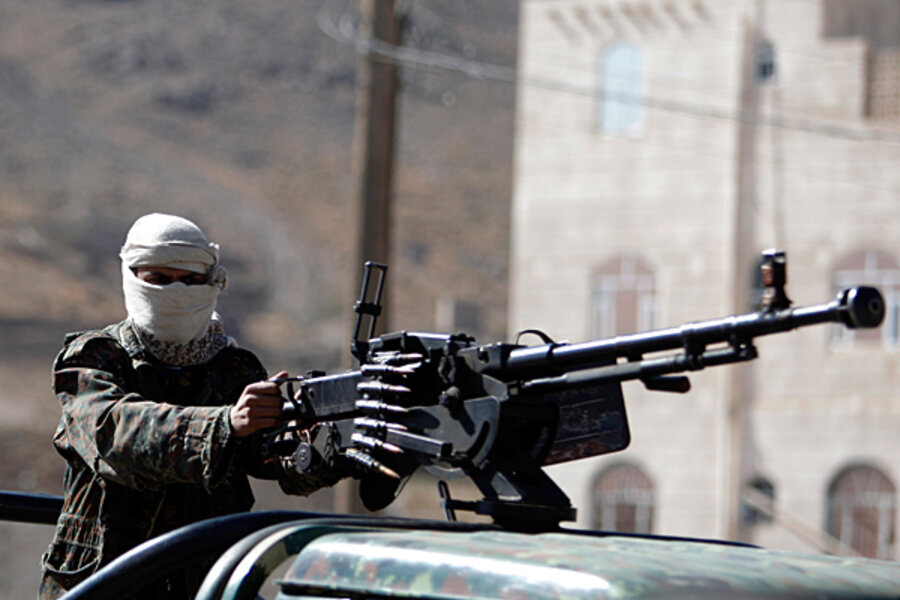In some parts of Yemen, 'the free south lives'
Loading...
| Al Dhale, Yemen
In Yemen’s decaying southern port city of Aden, everpresent graffiti declares “The free south lives.”
In the former southern capital, it’s an aspirational statement, a manifestation of increasing support for secession among southerners who want to reverse Yemen's 1990 reunification and restore independence to Yemen's south. But 80 miles north, the slogan almost reflects reality.
The rugged mountainous districts of al-Dhale, Radfan, and Yafa’ have long been hotbeds of revolt. Local tribesmen fought the British for independence in the 1960s and the northern forces in the 1994 civil war. Now these mountains have become the base of the Southern Movement, a collection of the most strident of the southern secessionist factions. Anger toward the capital simmers in this neglected, economically depressed area.
Supporters assert that the area is under “military occupation,” stressing that they view Sanaa’s control of the area as illegitimate. The flag of the former People’s Democratic Republic of Yemen (PDRY) flies openly on civilian buildings, the flag of unified Yemen flies over military checkpoints on the roads connecting the towns and troops, and tanks sit stationed on mountain ridges overlooking populated areas. Locals see the military presence as a sign that another crackdown is a constant threat.
Many here see secession as inevitable. Harsh military crackdowns on local antigovernment protests had the predictable outcome of radicalizing, rather than suppressing, residents. Local says that demonstrators' initial demands were about civil rights, but after seeing the Yemeni government’s response, they grew convinced that secession is the only solution.
“The northern Army has killed women, they’ve killed children, placing us under siege … this situation has continued until today,” says Ahmed Nasser Ali, a former southern soldier who, along with most of the other soldiers in the southern army, was discharged after the 1994 war. His town, Habilayn, was besieged by government forces for nearly three months in 2008. “Today, we want secession. Why? It’s a reaction, to free us from all of this.”
The military’s hand seems to dissipate as you approach al-Dhale, the capital of the province by the same name, and signs of government control are all but absent within its limits. Local Southern Movement leaders say they’ve largely taken over the tasks of governance, working alongside local tribal leaders and other Southern Movement figures in Yemen and abroad to maintain order.
The flag of the defunct southern state is a constant sight and secessionist graffiti coats government buildings. When asked who their president is, local children name exiled secessionist leader and former vice president Ali Salem al-Beidh, who was one of the chief architects of unification, then turned around and led secessionist forces in the 1994 war.
More moderate members of the movement have little, if any, popularity here, and local leaders nearly universally reject the possibility of dialogue with Sanaa. Their distrust extends beyond the central government to the international community, which sees Yemen's continued unification as nonnegotiable. Even the United Nations, locals argue, is biased, saying it focuses almost entirely on Sanaa, treating southerners as a side issue.
“Obviously, we know that the international community and the [UN] Security Council have a major impact on the southern issue,” says Abdullah Ahmed Hassan, vice president of the Southern Movement in al-Dhale. “But the way in which they deal with it is plainly unfair.”
The Yemeni government claims al-Dhale is the base of armed, radical secessionist factions backed by Iran – an accusation secessionist leaders strongly deny. They say the bulk of their financial support comes from southern businessmen based outside the country.
There has been a series of deadly attacks on soldiers stationed in the area, but local leaders deny the existence of organized militias, stressing their commitment to peaceful means and casting any violence against Yemeni troops as a result of popular anger.
While distancing themselves from the violence, secessionist leaders note with pride that the balance of power has seemingly shifted. Once forced underground due to their political activities, at least in al-Dhale itself, Southern Movement leaders appear to operate with seeming impunity, while their comrades face the threat of arrest elsewhere.
Few foresee the restoration of full government control, at least through peaceful means. But neither side seems eager for an escalation to armed conflict, meaning a tense stalemate will likely prevail for now.
The bravado of local secessionists underlines how much the power dynamics have changed.
“[The soldiers] have seen the power of the people and our unity, and they’ve fled in fear,” said Saleh Shaif Said, a Southern Movement activist in al-Dhale. “The occupying forces know they can’t touch us now.”







